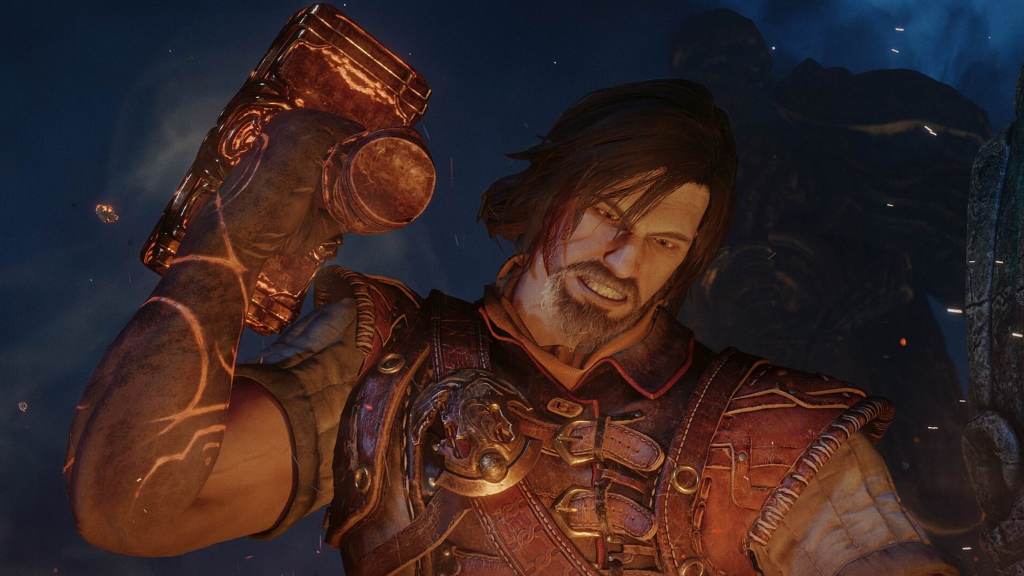
Blades of Fire is a bold new IP from MercurySteam, a developer best known for working with other studios’ IPs, including the likes of Metroid Dread and Castlevania: Lords of Shadow. MercurySteam has delved into its own works before, but Blades of Fire is the culmination of everything the studio has done. Upon booting it up, I was instantly thrust into an enchanting yet dark fantasy world. I battled hordes of enemies and deadly bosses in brutally strategic combat, explored diverse environments, and discovered a story inspired by nostalgic works. Blades of Fire certainly heats up the action RPG genre with unique ideas, but some areas clearly needed more time on the anvil.
Combat is the most important aspect of Blades of Fire. A mix of Soulslike elements, a touch of God of War influences, and MercurySteam’s own original systems create a thoroughly enjoyable combat experience. Early on, I was forced to master a four-way targeting system or die, attacking foes’ heads, left and right sides, or their lower half. Enemy weaknesses determine which area suffers damage and which would cause my strikes to bounce off. Weapons also offer different attack types like slashing, piercing, and blunt, with some weapons allowing you to switch between two types by changing which part of the weapon is used.
Further tactical elements are added in weapon type and durability, enemy placement and patterns, and a defensive system featuring dodging and blocking. Weapons are the core of Blades of Fire, providing almost all of Aran’s (the main character) stats. Equipping the right weapon is crucial not only to defeating enemies, but staying alive. Blades of Fire will highlight what parts of an enemy are vulnerable to the equipped weapon and which are resistant to it. Enemy weaknesses are made more complicated based on the weapon’s durability, losing weaknesses if the weapon is dull or an inefficient type.
Combat mostly feels fair in Blades of Fire. Some enemies are downright infuriating due to annoying mechanics, while others are merely challenging due to how many enemies and types are bunched up. Bosses, on the other hand, feel very fair and provide some of the most fun. Mastering Blades of Fire’s combat takes time, but getting the rhythm of it and learning what weapon is right for the job feels incredibly rewarding. Its slow and deliberate style proved to be one of my favorite combat systems in gaming.
Forging is the second most important part of Blades of Fire. Every weapon that Aran uses, except the two starting weapons, was forged by my own actions. Every stat it uses is determined by the material chosen and by mastering the forging mini-game. The goal is to forge a weapon with the most stars, thus increasing its reparability. The materials chosen influence a weapon’s damage, durability, sharpening cost, stamina, weight, length, and more.
REALTED: God of War Fans Need to Keep an Eye on Blades of Fire in May
Weapon durability is reflected in the quality of the forging. Weapons have a limited amount of durability, which is reduced when attacking enemies and when sharpened. Sharpening does restore a weapon’s damage output but reduces its durability, thus sacrificing longevity for damage. When a weapon’s durability reaches zero, it will break. It can then be repaired a number of times equal to the stars it was forged with. This creates a risk-reward system and forced me to manage my weapons carefully.

Where Blades of Fire is at its weakest is its story. I was treated to a brief exposition explaining the current world events before a friend of Aran was killed. Aran then wakes up the next morning and sets off on a mission to kill the evil queen. He is joined by Adso, whom he has just met, and the two adventure together, bantering as if they have known each other for years.
It feels very rushed early on and gave me no time to get my bearings. It eventually gets better, especially as you uncover lore from exploration and filling up Adso’s journal, but I found the surrounding world narrative more interesting than the actual plot. Blades of Fire’s NPCs offer charming moments and have loads of character, such as Glinda, a former Master Forger who wants nothing to do with Aran and his quest. The dynamic between Aran and Adso feels natural, and I quite enjoyed their moments together. But MercurySteam needed to have spent more time introducing the two and building this relationship for it to fully pay off.
The lackluster story is disappointing because of how incredible the world is. The background catalyst, the evil queen turning steel into stone, leaving mankind with no way to defend themselves, is incredibly interesting and drew me in. Discovering additional lore about the world only made me want to learn more. This paired well with the beautiful environments and aesthetics reminiscent of dark fantasy movies from the 80s like Excalibur and Labyrinth. I found myself getting lost in the vivid landscapes and dark dungeons as I searched for upgrades and completed puzzles.

However, I literally got lost in several areas. Some areas felt like actual labyrinths, and I often got turned around. Pairing this with the poor map interface gave me quite a few headaches trying to figure out where to go. That said, Blades of Fire does offer ways to open paths to make exploring and backtracking easier as well as a fast travel system. This gives it a Metroidvania feel that I loved. Overall, I appreciate how the game didn’t hold my hand on telling me where to go, I simply wished it were easier to get where I needed to be.
Blades of Fire is a promising game, especially for a new IP. MercurySteam has laid an excellent foundation, picking and choosing the best elements from other action RPGs and combining them with new ideas to create this engaging amalgamation. The world is fleshed out and a delight to discover, and the combat is the perfect balance of challenging and rewarding. The story of Blades of Fire needed more time and attention, but it served as a fine enough vessel to propel me through the delightfully dark world.
Rating: 4 out of 5
Blades of Fire was reviewed on PlayStation 5. A copy of the game was provided by the publisher for the purpose of this review.
The post Blades of Fire Review: Forged in Greatness appeared first on ComicBook.com.

